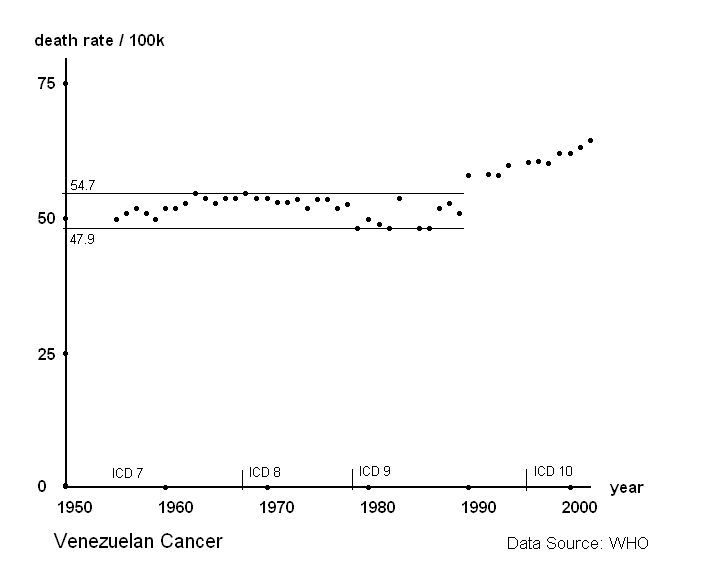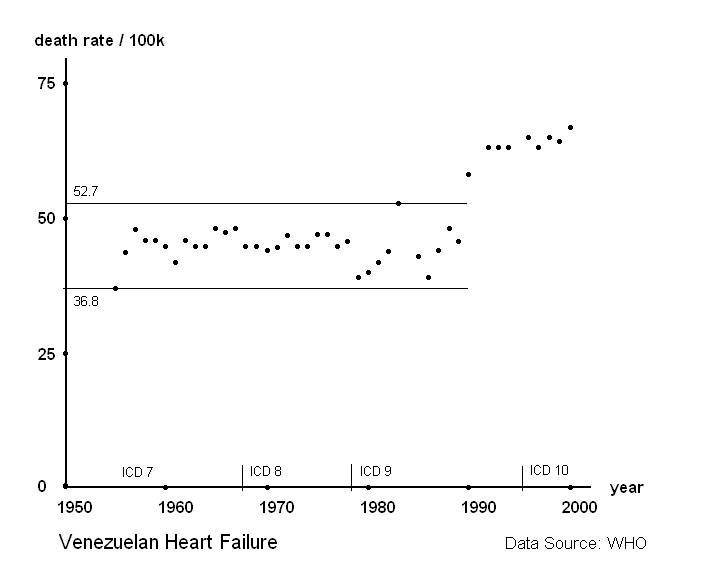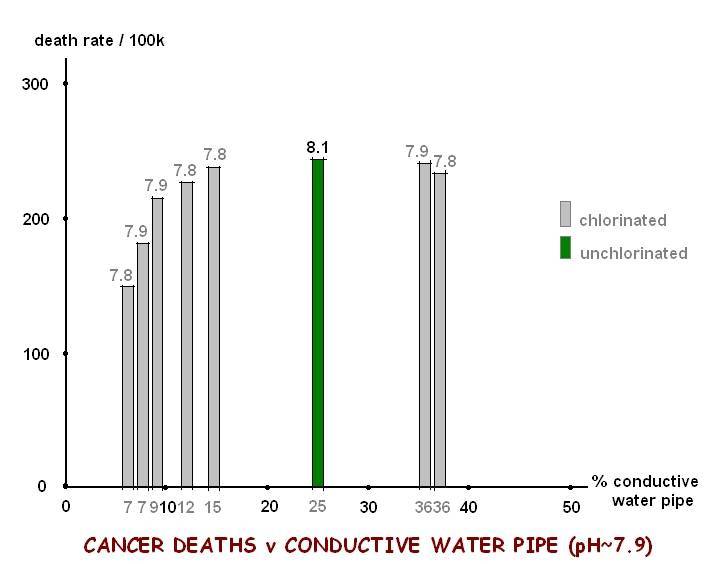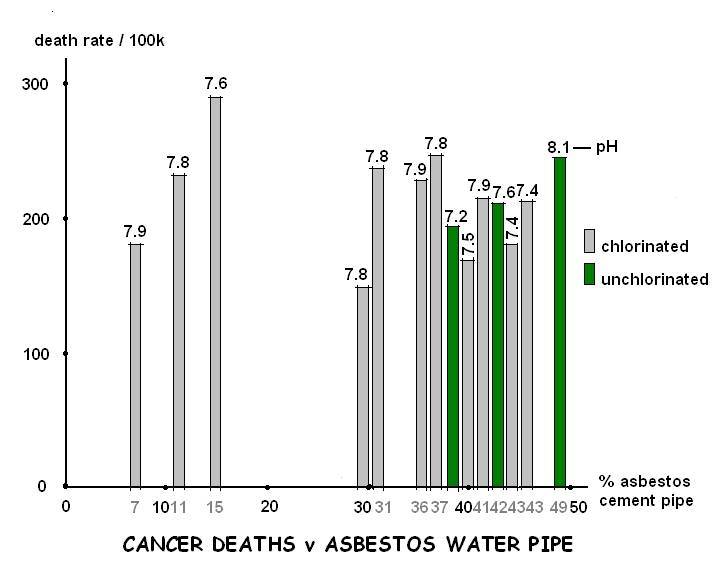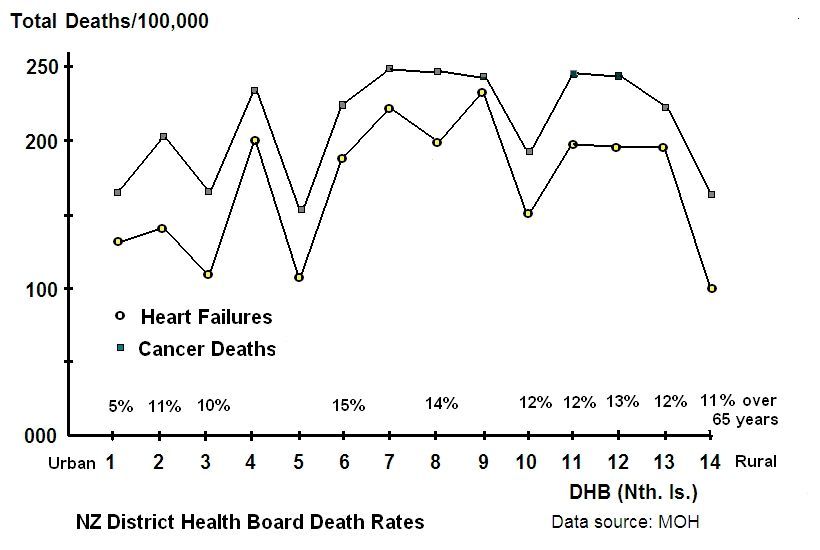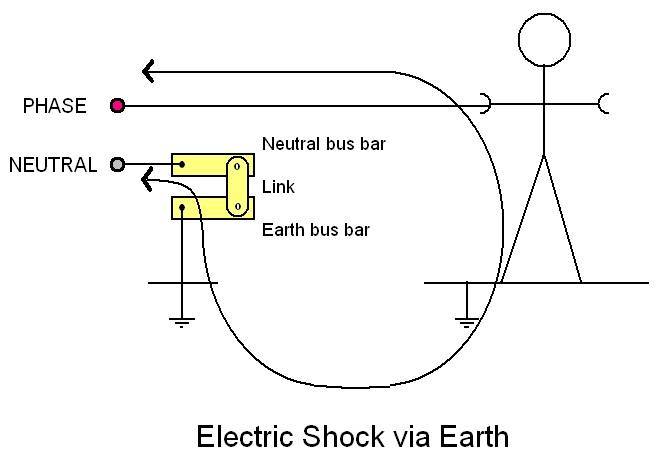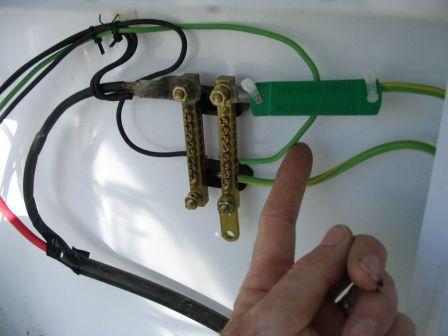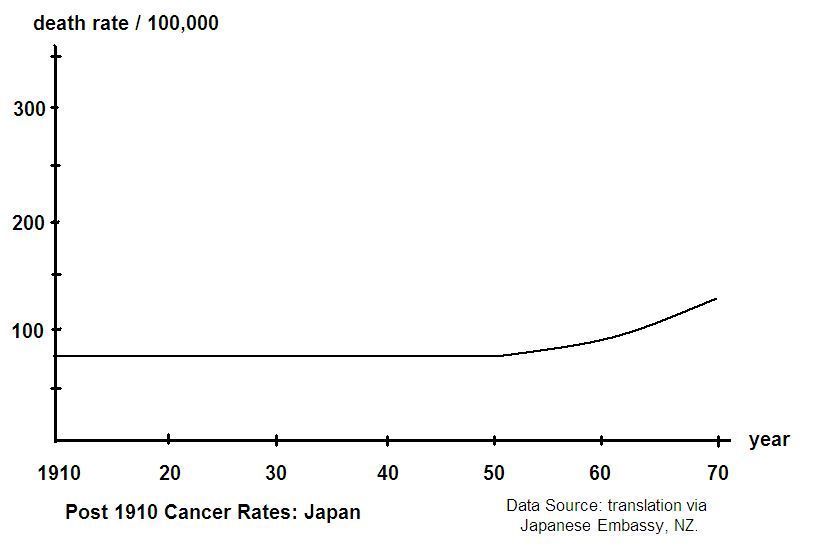
CANCER REPORT 2007:
how EARTHING and CHLORINATION are killing you
ISSN 1178-2994 Stephen G. Butcher
Author & Publisher: Stephen G. Butcher, "Harwood,"
RD4 Masterton, New Zealand.
Copies may be ordered from the above @ $8.00 incl. P&P. RRP $12.00 Online distribution $0.00
First Edition: September 2007
ISSN 1178-2994
Copyright © 2007 S.G. and S.M. Butcher
CANCER REPORT:
how EARTHING and CHLORINATION are killing you.
This report is a layman's summary of three years research intended initially for a PhD at Victoria University's School of Architecture, New Zealand. In it I hope to demonstrate the interaction between the building services' practices of electrical earthing (grounding) and water chlorination and their combined effect on cancer and heart failure.
But first, some history.
HISTORY:
Cancer is regarded as an epidemic.
It has not always been that way. Escalating cancer death rates have a clearly defined starting point. For instance, in Japan the cancer death rate, which had been historically flat, suddenly increased exponentially on U.S. occupation at the close of WWII.
Many countries in addition to Japan follow this exponential pattern. These countries could be called the "growth" group:

In some countries where cancer rates have increased dramatically post 1950 there has also been a decline in rates since about 1990. These countries could be called the "growth and decay" group:
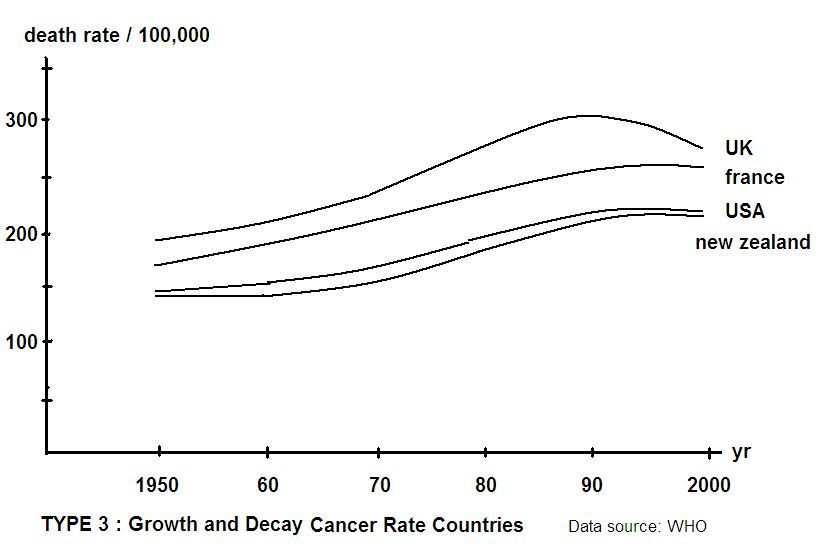
There is yet another group of countries in which the cancer epidemic appears not to have occurred at all! These countries might be called the "stable" group:

Clearly the so-called cancer epidemic is not a universal problem! From the perspective of someone in an industrialised country it might be easy to assume that it is, but the evidence speaks otherwise.
Given the ease with which people can and do move between countries, the inescapable conclusion is that these different cancer rate patterns are indicators of environmental differences that are weighted against industrialised countries. It cannot be explained away as a genetic trait, but is something man made.
Secondly, there is research which points to specific environmental factors having a major impact on cancer rates. Two of these factors are chlorinated water and electrical wiring codes.
WATER CHLORINATION:
Dr. Robert Harris demonstrated a clear connection between chlorination and cancer. The effect was in the order of a 90 -100% increase in cancer rates related to chlorinated water.
Another way of looking at cancer related to chlorination is to plot the change in cancer rate before and after chlorination to get a feel for the order of change over time.
South America has provided a recent example. Around 1991 Peru, with a failing infrastructure, had an outbreak of cholera which rapidly spread to other South American countries. Venezuela increased chlorination around 1991 as a result, and is valid as a test case (because of it's electrical wiring rules):
Here we see the beginning of an escalating cancer rate in an otherwise stable rate country. The increase is outside the range of recorded data up to the point of increased chlorination but, while increasing, has not yet reached the order of increase shown by Dr. Harris.
This is, however, not the only effect! Looking at heart failure rate data reveals a similar, and perhaps clearer, upward trend in rates:
There should be no surprises here. When water is chlorinated a very strong oxidising agent, hypochlorous acid, is produced:
H2O + Cl2
goes to
HCl + HOCl
To counter the damage that such an oxidising agent can do at a cellular level, the human body in defense makes use of an antioxidant called cholesterol. So the more hypochlorous acid taken in, the greater the level of cholesterol used to defend against it and the greater the risk of heart failure.
A further test case on the District Health Board (DHB) areas in the North Island of New Zealand shows a similar parallel incidence of cancer and heart failure:
1 Auckland
2 Lakes
3 Wellington
4 Hawkes Bay
5 Counties Manukau
6 Bay of Plenty
7 Whanganui
8 Wairarapa
9 Tarawhiti
10 Waikato
11 Tairahiti
12 Northland
13 Midcentral
14 Waitamata
The DHBs are most urban to most rural, and the % of the population over the age of 65 added where data are available. The parallel incidence here is a much stronger association than that with advancing age!
This gives a better indication of the parallel incidence of cancer and heart failure: this is an important concept to grasp and I hope the point is made. We cannot view cancer and heart failure as separate diseases: they are both presentations of common environmental factors.
The above graph is only for the 2000 data year. A further case study looking at the heart failure pattern back to 1950 for New Zealand as a whole shows a seeming contradiction in that heart failure rates were elevated prior to the increase in cancer rates:
That heart failure rates were elevated prior to 1950 is to be expected given that chlorination has been around since the early 1900s. The delayed effect of chlorination on cancer rates suggests that another environmental change occurred around 1950 which acted in conjunction with chlorination to modify its effect.
So we could say that prior to 1950 people were dying of heart failure from chlorination, but were unaffected in respect to cancer until another environmental factor was introduced.
ELECTRICAL WIRING:
In 1979 Nancy Wertheimer and Ed Leeper demonstrated an association between childhood cancers and electromagnetic fields (EMFs) in homes with earthed wiring (average odds ratio 3.0). In 1988 David Savitz made a further study confirming this association (average odds ratio 2.8).
Although an association exists, there appears to be no convincing causal process that relates EMFs to the cancer process. What appears to be often overlooked is that EMFs were the measurement tool. To say that they are causal is not necessarily a conclusion that can be drawn from those studies. What is important is that a connection was shown but the process by which cancer could be affected was not conclusively identified.
Taking an overview of changes to electrical codes, around 1950 the linking of earth and neutral busbars in AC meterboards became standard practice: this coincides with the post 1950 time frame of cancer rate increases and seems an obvious candidate as the additional environmental factor.
The practice of linking neutral and earth busbars is to increase the fault current to allow reliable fuse failure and, erroneously, reduce the possibility of fire. Here is Mr. Blog ensuring rapid fuse failure:
These bus bars can be found by swinging forward a meterboard, and are usually mounted on stand offs on the back of the enclosure:
The earth wires (me pointing) go to their own busbar, which is then connected by a brass link to the neutral busbar.
To understand how linking neutral and earth might have an effect on water chlorination, it is necessary to understand something of the nature of cancer which is common to both chlorination and electric power.
OVERLAP BETWEEN CHLORINE AND ELECTRIC POWER:
In 1922 William Chambers demonstrated that the pH of the blood in cancer sufferers was more alkaline than normal.
Similarly, in the mid 1900s Otto Warburg found that a normal cell could be induced to become cancerous by restricting its oxygen supply: that the fundamental difference between a normal cell and a cancerous one was that the normal cell was aerobic but the cancer cell was anaerobic. I view his work from another perspective. I see it more as a question of balance: the cancer cell has an excess of hydrogen which would present the same way as a shortage of oxygen, when considering the work of Chambers.
To look at it another way, a tumour would appear to need a blood supply. But it can't be to access oxygen as the cancer is anaerobic: so it seems far more probable that the blood supply is needed to access hydrogen ions. The blood supply then becomes increasingly alkaline as the demand from the replicating cancer cells increases.
In the 1990s several groups of researchers were looking for a change in the DNA of cancer genes which turned the cancer cell "on." It was found to be a point mutation where a glycine was replaced by a valine, with 6 extra hydrogens:

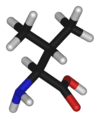
glycine valine Source: Wikipedia
This supports the notion that hydrogen ions play a part in cancer cell replication.
The overlap between these organic ions and man made inorganic AC power is that both involve electrons.
Now, the notion that earth (ground) is uninvolved unless there is an electrical fault condition is false. For example, in a single phase circuit the current must be shared between neutral and earth in proportion to their respective resistances:
Additionally, when neutral and earth are linked then so too is conductive water piping. Conductive pipes are equipotentially bonded to earth so, obviously, if neutral is connected to earth it must also be connected to conductive water pipe and the opportunity for chlorinated water to be affected by AC power exists.
Water chlorination can supply hydrogen ions: the addition of chlorine to water produces hydrochloric acid which almost completely ionises in water to produce H3O + ions. HCl is therefore very acidic with a pH around 1 compared to a neutral or balanced pH around 7.
Rather than viewing chlorine as causing cancer, it might be viewed as involved only to the extent of its ability to provide hydrogen ions: it would be the hydrogen ions themselves which relate to cancer rates and then only as the ionisation is affected by AC.
In the case study showing the parallel incidence of heart failure and cancer, DHBs were used. In the case study below Territorial Authorities (TAs) are used to better focus on those populations serviced by reticulated water supplies with the same pH to see the relation between conductive water pipe and cancer:
This suggests that after a certain % of conductive pipe is exceeded, the effect on ionisation reaches saturation.
As a comparison, many TAs use asbestos cement water pipe: increased acidity could be expected to erode asbestos cement pipe and release asbestos fibre, a known carcinogen, into the water supply. The association between asbestos, pH and cancer is shown below:
There appears to be, therefore, a much stronger association between conductive water pipe and cancer than asbestos water pipe and cancer.
THE CHEMISTRY OF CANCER AND HEART FAILURE:
The preceding suggests that there are two factors interacting to affect cancer and heart failure as different presentations of the same electro-chemical illness (ECI). In practice it is probable that heart failure precedes or has first pick at causing death as the body attempts protection against cellular damage, followed closely by cancer. At this stage in the research the process might be described thus:
We appear to have two building services interacting in a way which is not possible to visualise if approached in the industrialised, specialised way of current research methods. If we cannot recognise the need to look with an open mind at how things relate across disciplines then we will continue to be bullied by protocols which suit a product-driven economy.
At the close of 2005 when proposing to change from a Masters to a PhD, I had to decide between viewing the power/cancer connection as an effect of EMF or, on the advice of Jim Sprott, as an ionic effect and I chose the latter. Now, two years later and having continued my research outside the university, I still think that the ionic/cancer connection is the more plausible explanation. That a connection exists is beyond doubt.
I suggest that we need to look further than EMF and cancer, further than chlorine and cancer, and further than chlorine and heart failure to see the underlying ionic processes that affect them all, the common factor which makes them all relate.
(continued) Stephen Butcher (B. Arch)
